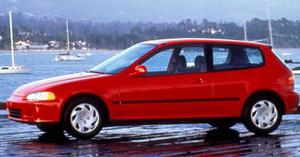
Maricopa is not immune to crimes such as vehicle theft. In the United States, the annual loss from car theft is more than $4 billion. The Automotive Information Council reports that more than one million motor vehicles are stolen in the U.S. each year. That’s one motor vehicle theft every 31 seconds.
For a variety of reasons, some motor vehicles have a greater probability of being stolen than others. The following are some of the most stolen motor vehicles in the U.S. and their model year:
10 most stolen motor vehicles*
1. Honda Civic (1995)
2. Honda Accord (1991)
3. Toyota Camry (1989)
4. Ford F-150 (1997)
5. Chevrolet C/K 1500 (1994)
6. Acura Integra (1994)
7. Dodge Ram Pickup (2004)
8. Nissan Sentra (1994)
9. Toyota Pickup (1988)
10. Toyota Corolla (2007)
*National Insurance Crime Bureau 2008 statistics
Motor vehicle crime-prevention tips
• Lock it and pocket the keys. Nearly 20 percent of all vehicles stolen had the keys in them. Remember to lock the trunk, the hatchback or the tailgate of a station wagon or sport utility vehicle.
• If your motor vehicle is an older model, replace standard door lock buttons with tapered ones. These replacements are inexpensive and much more difficult to pry up.
• Don’t leave motor vehicle registration, insurance policies, credit cards or other important papers in a vehicle’s glove compartment.
• If you use a self-service gasoline stations or convenience stores, don’t leave the keys in the vehicle when you go inside to pay your bill.
• Don’t place a mini-replica of a license plate or personal identification on a vehicle’s key ring.
• Consider installing safety security film on the windows. With the film added to the glass, the window will be 300 to 400 percent stronger. Intruders must cut their way through the glass, thus taking more time. The safety film is clear and reflects up to 98% of the sun’s ultraviolet rays.
• Never hide a second set of keys in the vehicle. Extra keys can easily be found if the thief
takes time to look. Store a spare key in your wallet.
• If possible, avoid parking next to vans, pick-ups, and other large vehicles. These large vehicles can “hide” your vehicle and make it more difficult for others to observe.
• When parking along a curb, angle the front wheels sharply to the left or right, making it difficult for the thief to tow it away. Wheels should also be turned to the side in driveways and parking lots.
• If your vehicle is rear-wheel drive, back into your driveway. Rear wheels lock on four-wheel drive vehicles, making them difficult to tow. Front-wheel drive vehicles should be parked front end first.
• Periodically check your license plates to make sure they haven’t been stolen, switched or altered.
• Join Operation Identification and engrave your driver’s license number or social security number in several concealed places on, or in your motor vehicle. Drop a business card into the window channel, beneath the seat or behind the dash panel.
• Engrave batteries, wheel covers and car stereos with either your drivers license number or social security number preceded by your state’s initials.
• Don’t invite a vehicle break-in by leaving packages or valuables (radar detectors, cellular phones, CD players, etc.) in sight. Take valuables with you, put them under the seat or lock them in the trunk.
• Whenever possible, park in well-lighted and busy areas.
• Whenever possible, park in an attended lot. Motor vehicle thieves do not like witnesses and prefer unattended parking lots.
• When you park in an attended lot, leave only the ignition/door key. If your trunk and glovebox
use the same key as the door, have one of them changed. Leaving the ignition key with the attendant, retain all others and be sure the key number does not appear on the key that is left.
• On cold mornings, never leave your motor vehicle running while it is unattended, in order to warm up.
For each vehicle you own or lease, record the following information and keep it in a safe location (not in the vehicle):
Make and model year
Registration number (plate)
Vehicle Identification Number (VIN)
Color
Name of insurance company and Agent
Engine size
Any peculiarities of vehicle (dents, pin stripes, etc.)
Key number
Avoid transferring items to the trunk of a vehicle where it is to be parked. A thief may be watching. Checkbooks, credit cards or other credentials, which a thief could misuse, should not be left in a motor vehicle.
• Park as close as possible to an open business.
• If you have a garage, use it. Lock your garage door. Also lock your vehicle doors, even when it’s in the garage.
• When going out of town and leaving your motor vehicle, if possible, remove the electronic ignition fuse, rotor distributor or the coil wire.
• If you see a disabled motor vehicle, don’t stop. Instead, drive to a nearby telephone and inform the police of the vehicle’s location.
• If your vehicle becomes disabled, attach a white handkerchief to the door handle or window, lock the doors and stay inside the vehicle. If someone stops to help, do not open your door or window. Ask the person to please go to a telephone and call for help.
• Possibly use cane type steering wheel locks. The metal cane hooks around the brake pedal on one end, and around the steering wheel rim or spoke on the other. The device is drawn tight and locked with a key.
• You may also use a temporary snap lock which fits over the bulge in the steering column of late-model American cars, where the ignition switch is, and prevents the ignition from being turned on.
• Don’t disconnect the buzzer that warns of keys left in the ignition. It’s for your protection.
• Possibly use a locking gas cap, not only to prevent theft of gasoline, but to limit a thief to the amount of driving he can do on one tank.
• There are special locks made for various marketable parts of cars. Battery locks or wheel cover locks may save these items.
• If your vehicle is not already equipped with one, install an interior hood release.
• Install different locks for the door, ignition and trunk. A thief who might obtain your vehicle’s door key still won’t have the ignition key.
Photo courtesy of American Honda Motor Co.

![O’Reilly gears up for second Maricopa location An exterior view of O'Reilly Auto Parts on John Wayne Parkway on May 2, 2024.[Monica D. Spencer]](https://www.inmaricopa.com/wp-content/uploads/2024/05/spencer-050224-oreilly-second-location-web-218x150.jpg)
![Province writer opens the athlete’s mind in new book Tom Schuman, a Province resident, poses with a copy of his new book, "My Wide World of Sports," outside his home on May 2, 2024. [Monica D. Spencer]](https://www.inmaricopa.com/wp-content/uploads/2024/05/spencer-050224-tom-schuman-sports-book-web-01-218x150.jpg)








![City gave new manager big low-interest home loan City Manager Ben Bitter speaks during a Chamber of Commerce event at Global Water Resources on April 11, 2024. Bitter discussed the current state of economic development in Maricopa, as well as hinting at lowering property tax rates again. [Monica D. Spencer]](https://www.inmaricopa.com/wp-content/uploads/2024/04/spencer-041124-ben-bitter-chamber-property-taxes-web-218x150.jpg)
![Maricopa restaurateur makes Food Network connection [Namkeen Dhaba]](https://www.inmaricopa.com/wp-content/uploads/2024/04/439456716_377105198650519_7536248579664805896_n-218x150.jpg)

![O’Reilly gears up for second Maricopa location An exterior view of O'Reilly Auto Parts on John Wayne Parkway on May 2, 2024.[Monica D. Spencer]](https://www.inmaricopa.com/wp-content/uploads/2024/05/spencer-050224-oreilly-second-location-web-100x70.jpg)
![Province writer opens the athlete’s mind in new book Tom Schuman, a Province resident, poses with a copy of his new book, "My Wide World of Sports," outside his home on May 2, 2024. [Monica D. Spencer]](https://www.inmaricopa.com/wp-content/uploads/2024/05/spencer-050224-tom-schuman-sports-book-web-01-100x70.jpg)

